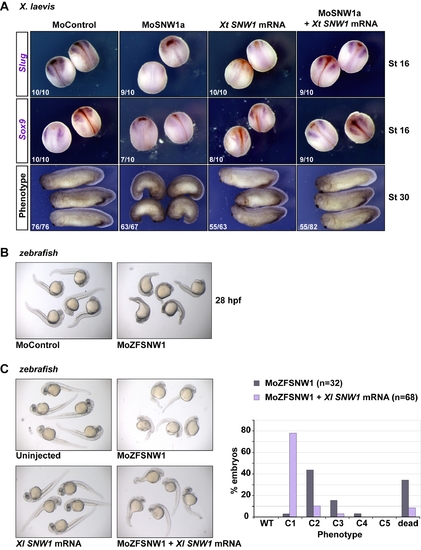Fig. S4
- ID
- ZDB-FIG-110321-27
- Publication
- Wu et al., 2011 - SNW1 Is a Critical Regulator of Spatial BMP Activity, Neural Plate Border Formation, and Neural Crest Specification in Vertebrate Embryos
- Other Figures
- All Figure Page
- Back to All Figure Page
|
Overexpression of SNW1 can rescue the effects of SNW1 depletion in Xenopus and zebrafish. (A) The effects of SNW1 knockdown in X. laevis embryos can be rescued by overexpression of X. tropicalis SNW1. Embryos injected with 20 ng of control MO, 20 ng of MoSNW1a, 500 pg of X. tropicalis SNW1 mRNA, or both MoSNW1a and X. tropicalis SNW1 mRNA at the one-cell stage. Neural crest induction was assayed by WISH for Slug and Sox9 at stage 16. The phenotype was analyzed at stage 30. The number of embryos out of the total analyzed that showed the presented staining pattern/phenotype is given. (B) Zebrafish embryos were injected with 15 ng of either control MO or MoZFSNW1. They were photographed for phenotype analysis at 28 hpf. The morphant embryos present a dorsalized-like phenotype, but also display necrosis in the head, which is not rescued by p53 MO co-injection (data not shown [78]. (C) Overexpression of X. laevis SNW1 partially rescues the effects of SNW1 knockdown in zebrafish. Embryos were either uninjected or injected with 7.5 ng of MoZFSNW1, 125 pg of X. laevis SNW1 mRNA, or both. Embryos were cultured until 40 hpf, when they were analyzed for phenotype. MO-injected embryos and embryos injected with both the MO and the rescue mRNA were scored for a dorsalized phenotype (looking only at the extent of posterior structures) as in [71] (righthand graph). |
| Fish: | |
|---|---|
| Knockdown Reagent: | |
| Observed In: | |
| Stage: | Prim-5 |

